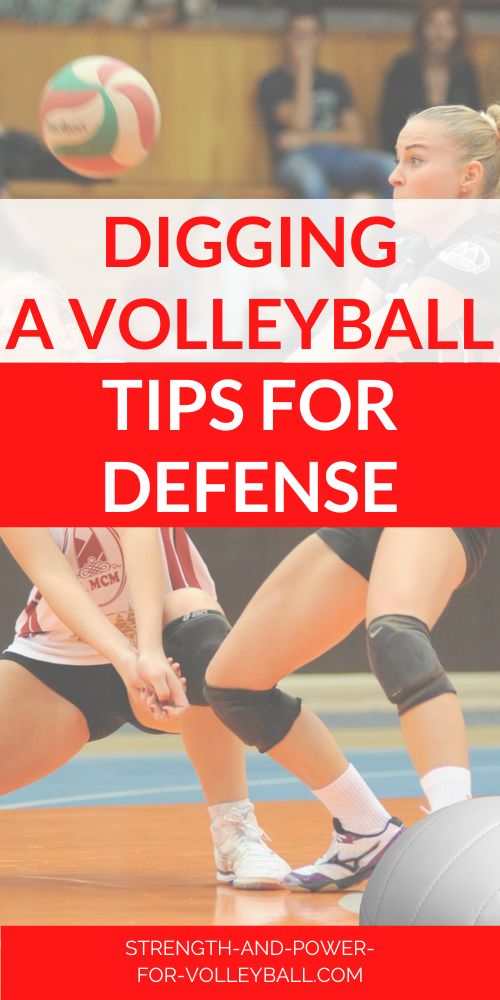A Dig in Volleyball
What's a Dig and How to Do It
A dig in volleyball is when an athlete makes a defensive play that keeps the ball from hitting the floor. Most of the time a dig is defined by how the defensive player plays a ball that's been spiked by the opponent. A dig is done when a hard hit ball is dug by a defender.
There are situations where volleyball players will intercept hard hit balls. This is called digging a hard hit.
What's the Purpose of a Dig in Volleyball?
The reason you want to dig in volleyball is to prevent the opponent from scoring a point. The better a team is at keeping the ball from contacting their teams court, the better chance the team has at winning the point.
A dig is done when playing defense. This is different than passing in serve receive. When receiving a serve, the player has more time to anticipate and move to get in position to pass. Often with digging, the player doesn't have time to anticipate. The dig is often done just be quickly getting into a digging position. A defensive player will often be covering a certain area of the court. The defensive player needs to be ready to react quickly to the opponents attack.
What Players Perform a Dig in Volleyball?
Since digging involve playing balls that are hit with a lot of force, most of the time it's the back row players that are the ones digging.
On defense, the front row players are mainly responsible for blocking. Some situations are front row player would drop off the net and dig a hard driven spike that is hit as an extremely sharp angle. In this situation, these defensive plays would be called digs.
However, most of the time it's the back row players that are the ones the need to develop skills for digging hard driven spikes.
How to Dig in Volleyball?
Here are some tips for digging a volleyball.
Be ready to move. The first thing you need to do as a defensive player is be ready to move quickly in any direction. To dig a ball successfully, you need to be in the correct position to dig. This means you may need to take a step to get to the correct spot for receiving the ball. If you aren't in the correct spot, you won't be able to get your body into the correct position for making a successful dig.
Have weight on your toes. You don't want to make the mistake of starting your defense by leaning back on your heels. If you have weight on your heels, you are committed to the position your are in and can't adjust your position. You need to be ready to move quickly. Start with weight on your toes (balls of the feet) and be ready to step quickly to you can get in position to dig.
Stay low with knees bend. If your body is low and knees are bent, you are in a good position to move your body. Be in a low position that is comfortable to move and easy to adjust your body position to dig.
Learn the skill of digging a ball. Practice the digging position. Angle the arms and practice digging hard driven balls. A lot of times digging is more about reacting and less about anticipating. A good digger has good reaction skills. To dig successfully you need to react quickly and make a good decision on how to absorb the hit and dig the ball in such a way that the ball stays in play on your team's side of the court. A good digger will make it easier for the setter to get to the ball to set.
Learn the skills of moving to pass. When playing defense, you aren't just digging hard spikes. You will also need to anticipate the hitter, read the hitter and run down tips on defense. You need to learn how to move your feet to the ball and make athletic plays to save the ball and pass the ball to the setter.
Game-like drills for digging. Be sure to practice digging in a game situation. The defensive player needs to see the setter set a hitter. Watch the hitter and read them to anticipate how the hitter is going to hit the ball. For example, if the hitter is going to tip the ball, you need to see that they are doing this before they do it. If you can successfully read them, you will get a quicker step in the correct direction for making the play. This split-second decision can be the difference between making a successful play on the ball.
Practicing digging a harder hit ball. To become good at digging you can practice digging a ball that is hit harder than what you would normally seen hit. If you can dig the harder hit, you will be a lot more comfortable digging the slower hit balls.
If you enjoyed these tips and would like to keep it close to you at any time, just save this pin to your Pinterest Volleyball Training Board.
Your second block of text...
